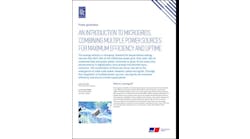At the British Columbia Institute of Technology, researchers hope that their microgrid research will someday create a living lab that allows the entire campus to island from the grid.
But here’s the problem: conducting the research is like building a race car while participating in the Grand Prix, said Hassan Farhangi, director of the Smart Microgrid Applied Research Team.
“We’ve been doing this research for nine years, and we’re just scratching the surface,” he said. “The issue is how can you build a race car and at same time participate in the Grand Prix?” The US is introducing a lot of new technology to the grid, and there’s an expectation that the grid will be 150 percent available, he added.
“We realized that we needed to introduce pockets of technology across the campus where it made sense. We picked a part of campus where we could introduce it and later integrate it through the backbone,” he said.
The first was a 4-kWh battery that is fed by a wind turbine situated on a net-zero home.
Next BCIT developed an intelligent thermal combustion turbine that feeds energy to a 75-kWh battery. The turbine runs on a number of different resources, including natural gas and waste wood. The turbine could possibly be used to island a small portion of the campus’s 6-MW peak load, he noted.
Most recently, BCIT developed a solar powered EV charging station that utilizes 250 kW of solar power, and a 500-kWh battery.
[clickToTweet tweet=”#Microgrid Research: Building a Race Car While Racing in the Grand Prix @bcit” quote=”Microgrid Research: Building a Race Car While Racing in the Grand Prix”]
BCIT, working with partner BC Hydro and a number of corporations, envisions that this is a model for the gas station of the future. Under the Energy OASIS (Open Access to Sustainable Intermittent Sources) project, the institute will build a network of fast-charging stations that can charge cars in minutes without stressing the grid, says the institute. The project includes solar panels mounted on the parking canopy, EV fast chargers and energy storage.
One of the goals of the project is to be able to island and charge electric vehicles.
“The second objective was to look at the impact on the health of the utility feeder of large clusters of EVs charging. If you have huge amounts of load you need to know how to charge without jeopardizing the utility feeder,” Farhangi said.
The requires identifying how much electricity is needed for the EVs, and in a sense, rationing it. “EV stations have to follow a different approach,” he said. “In a gas station, you fill up your car irrespective of what you need that day. But energy is finite and the grid is under stress.”
Under the BCIT approach, a car pulls up to the charging station and the attendants talk to the drivers about how much charge they have left and how far they’re heading. “We figure out how much energy will be required to get to the next charging station. We ration the energy delivery,” said Farhangi.
In addition to the EV work, the researchers are looking into the load profiles of commercial, industrial and residential buildings on campus. They include a cafe and student community center, dorms and labs with heavy equipment and machinery.
To date, about $30 million in public/private money has been invested in the microgrid research project. That includes government money and donations from corporations. Siemens Canada is one of the partners in the project, and will focus on developing technologies for cost-effective and environmentally sound electrification in Canada, said a Siemens press release. The partners will also look into security issues.







